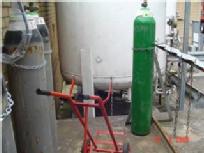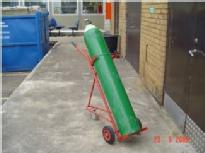Handling Cylinders
Gas Cylinders are heavy and can present a high centre of gravity relative to the user.
Ensure that you are trained to use the gas moving trollies and that you are able to deal with the mass [weight] of the cylinder and trolley before you attempt to move them. You must be trained to handle gas cylinders.
| Do: | Don't: |
| Check cylinder is upright [vertical] in the storage area | Move a cylinder which is in a horizontal, or obviously unstable, position – seek assistance from safety officer(s). |
| Check the mass [weight] of the chosen cylinder by gentle rocking to gauge your ability to move it [unchain from the stillage if necessary]. |
Move a cylinder with a valve key [spanner] in the valve. |
| Safety Footwear must be worn to handle cylinders. Use risk assessment to determine if other PPE is required [e.g. gloves/eye protection]. | Churn the cylinder for excessive distances. |
| Ensure correct identity tag is attached to the neck of the cylinder. |
Move a cylinder if there is any obvious leakage from it. |
| Select a suitable cylinder trolley for the size of the cylinder | Leave a cylinder unrestrained. |
| Unchain the cylinder and ease out of the stillage by alternate tip and roll technique. | |
| Churn* the cylinder to move it, locate into the trolley and secure by the chain | |
| Ease the trolley backwards to take the load off the ground. | |
| Move to the point of use. | |
| Repeat the process in reverse to mount the cylinder. | |
| Secure by restraint. | |
| Hang tag on hook |
*churn = tilt slightly towards you from vertical, support the weight; carefully rotate the cylinder so to move over the surface. TRAINING REQUIRED.
|
|
Gas cylinder and transport trolley |
 |
Note : this is just one type of trolley |

